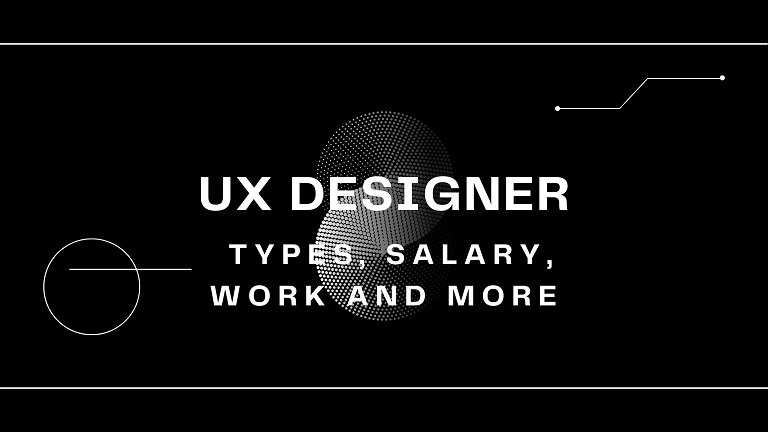UX Designer – Types, Salary, Work and More in 2024
Hello friends, today we will know about UX Designer.
What is UX Designer?
User experience (UX) design is the process of creating products or services that provide a positive and seamless experience to the user. A UX Designer is responsible for creating user-centric designs that are visually appealing and easy to use.
Here are some key responsibilities of a UX Designer:
User research: Conducting user research to understand the target audience and their needs is a critical part of a UX Designer’s job. This involves gathering data from surveys, interviews, and analytics to inform the design process.
Wireframing: A UX Designer creates wireframes that act as blueprints for the layout and structure of the product. Wireframes help designers visualize the user interface and the user flow.
Prototyping: Prototyping involves creating a functioning model of the design, which allows designers to test and refine the design before the final product is created.
Designing: A UX Designer creates visual designs that are both aesthetically pleasing and functional. This involves selecting colors, typography, and other visual elements that enhance the user experience.
Testing: Testing the design with users is a critical step in the UX design process. This allows designers to identify any usability issues and make necessary changes.
Collaboration: UX Designers collaborate with other members of the product team, such as developers, product managers, and marketing teams, to ensure that the design meets the needs of all stakeholders.
Iteration: UX Designers use an iterative process to continuously improve the design based on user feedback and data.
Accessibility: A UX Designer ensures that the design is accessible to all users, including those with disabilities, by following accessibility standards and guidelines.
Documentation: Documenting the design process and design decisions is an important part of a UX Designer’s job. This ensures that the design is consistent and can be easily updated and maintained.
Keeping up with industry trends: A UX Designer must stay up to date with the latest trends and technologies in the field to ensure that their designs are innovative and relevant.
Overall, a UX Designer plays a crucial role in creating products or services that provide a positive and seamless experience to the user.
They must have a deep understanding of user needs and behaviors and be able to translate that into visually appealing and functional designs.
How to Become an Information Security Analyst

Types of UX Designer
Here are some common types of UX Designer:
User Researcher: A UX Designer who specializes in research to understand the needs and behaviors of users.
Interaction Designer: A UX Designer who focuses on designing the interactions between users and digital products, such as the layout of buttons and menus.
Visual Designer: A UX Designer who specializes in creating the visual elements of a product, such as color schemes, typography, and iconography.
Information Architect: A UX Designer who organizes information and content in a way that is easy for users to understand and navigate.
Content Strategist: A UX Designer who specializes in creating and managing content for digital products, such as website copy and social media posts.
UI Designer: A UX Designer who focuses on designing the user interface of a product, including the placement of visual elements and the flow of user interactions.
UX Writer: A UX Designer who specializes in writing and editing content that is clear, concise, and easy for users to understand.
Usability Tester: A UX Designer who conducts user testing to evaluate the usability of a product and identify areas for improvement.
It’s important to note that these roles can often overlap, and some UX Designers may have expertise in multiple areas. The specific roles and responsibilities of a UX Designer can also vary depending on the organization and the product being designed.
How to become a UX Designer
To become a UX Designer, you will typically need a combination of education, experience, and skills. Here are some steps you can take to pursue a career in UX Design:
Education: A bachelor’s degree in a related field such as graphic design, computer science, psychology, or human-computer interaction can be beneficial. However, there are also many successful UX Designers who have gained skills through self-study or non-traditional education.
Build a portfolio: Creating a portfolio of your work is important to showcase your skills and experience to potential employers. Include projects that demonstrate your ability to conduct user research, design interfaces, and solve problems.
Gain experience: Start by seeking internships, freelance projects, or entry-level positions to gain practical experience in UX Design. This will also allow you to build your portfolio and network with other professionals in the field.
Develop skills: UX Designers need to have a strong foundation in design principles, user research methodologies, and software tools such as Sketch, Figma, or Adobe XD. It’s also important to have skills in communication, collaboration, and problem-solving.
Stay current: The field of UX Design is constantly evolving, so it’s important to stay up-to-date with the latest trends, technologies, and best practices. Attend industry events, read blogs and books, and participate in online communities to stay informed.
Consider certification: Earning a certification in UX Design, such as the Certified UX Professional (CXUP) or Certified Usability Analyst (CUA), can demonstrate your expertise and commitment to the field.
Ultimately, becoming a successful UX Designer requires a combination of education, experience, and ongoing learning. It’s important to be passionate about creating great user experiences and committed to continuously improving your skills and knowledge.
What is the salary of a UX Designer in India?
The salary of a UX Designer in India can vary depending on factors such as experience, skills, location, and company size. According to payscale.com, the average salary of a UX Designer in India is around ₹630,000 per year.
However, entry-level designers may start with a salary of around ₹300,000 per year, while experienced designers with a strong portfolio and skills in emerging technologies can earn upwards of ₹2,000,000 per year.
Salaries can also vary based on the industry, with UX Designers in the technology sector typically earning higher salaries compared to those in other industries.
What is the salary of a UX Designer in Foreign Countries?
The salary of a UX Designer in foreign countries can vary depending on the location, company size, experience, and skills.
According to Glassdoor, the average salary of a UX Designer in the United States is around $85,000 per year, while in the United Kingdom, the average salary is around £40,000 per year.
In Canada, the average salary of a UX Designer is around CAD 70,000 per year. These figures are just averages and can vary based on the factors mentioned above.
Experienced designers with a strong portfolio and skills in emerging technologies can earn significantly more than these average salaries.
10 responsibilities of a UX Designer
Here are 10 common responsibilities of a UX Designer:
Conduct user research: UX Designers must understand the needs, behaviors, and preferences of users. They conduct user research to gather data and insights that inform the design process.
Develop user personas: Based on user research, UX Designers create user personas to represent different user types and their needs. Personas help guide design decisions and ensure that user needs are met.
Create wireframes and prototypes: UX Designers create wireframes, which are visual representations of the user interface that show the layout and structure of a website or app. They also create prototypes, which are interactive models that allow users to test and provide feedback on the design.
Design user interfaces: Based on wireframes and prototypes, UX Designers design the user interface, including the visual elements, navigation, and interactions.
Conduct usability testing: UX Designers test the usability of the design by conducting user testing and gathering feedback. They use this feedback to refine the design and improve the user experience.
Collaborate with cross-functional teams: UX Designers work with other designers, developers, product managers, and stakeholders to ensure that the design meets business goals and user needs.
Stay up-to-date with design trends: UX Designers keep up-to-date with the latest design trends and technologies to ensure that their designs are innovative and competitive.
Ensure accessibility: UX Designers ensure that the design is accessible to all users, including those with disabilities.
Conduct A/B testing: UX Designers conduct A/B testing to compare different versions of the design and determine which is more effective.
Document design decisions: UX Designers document their design decisions and rationale to communicate with other team members and ensure that the design is consistent and meets project requirements.
How to Become a Mathematician or Statistician
UX Designer Specialist
A UX Designer Specialist is an experienced UX Designer who has honed their skills in a particular area of user experience design.
They possess advanced knowledge and expertise in a specific aspect of UX design and can provide specialized guidance and leadership in their area of specialization. Here are a few examples of UX Designer Specialists:
Interaction Designer: Interaction Designers specialize in designing how users interact with a digital product, such as the flow of screens, gestures, and animations.
Visual Designer: Visual Designers specialize in creating the visual elements of a digital product, including the color scheme, typography, and iconography.
Information Architect: Information Architects specialize in organizing and structuring content to make it easy for users to find what they need.
User Researcher: User Researchers specialize in conducting user research to understand user needs, behaviors, and preferences and use these insights to inform the design process.
Usability Tester: Usability Testers specialize in testing the usability of digital products and provide feedback to improve the user experience.
Content Strategist: Content Strategists specialize in creating and managing the content of digital products, ensuring that it is engaging and meets user needs.
Accessibility Specialist: Accessibility Specialists specialize in ensuring that digital products are accessible to all users, including those with disabilities.
UX Designer Specialists often have several years of experience in UX design and have developed a deep understanding of their area of specialization through training, research, and hands-on experience.
They are valuable assets to UX design teams and can help ensure that digital products are optimized for the best possible user experience.

FAQ
Is UX design coding?
While coding is an important aspect of creating digital products, UX design is not primarily focused on coding.
User experience (UX) design involves understanding user needs, behaviors, and preferences and using that information to design intuitive, effective, and enjoyable digital experiences.
UX designers use a variety of tools and techniques, such as wireframing, prototyping, user testing, and information architecture, to create designs that meet user needs and goals.
While some UX designers may have a basic understanding of codings, such as HTML and CSS, it is not typically a core requirement for the job.
That said, having some knowledge of coding can be helpful for UX designers in communicating with developers and understanding the technical constraints and possibilities of their designs.
However, UX designers typically work closely with developers and other technical professionals to bring their designs to life through coding and development.
What qualifications do I need to be a UX designer?
To become a UX (user experience) designer, you typically need a combination of education, experience, and skills. Here are some common qualifications:
Education: A degree in a related field such as graphic design, interaction design, human-computer interaction, or psychology can be helpful, although it is not always required.
Some UX designers have degrees in unrelated fields such as engineering, business, or the humanities.
Experience: UX design is a field that values experience and practical skills, so having a portfolio of design work and case studies can be more important than formal education.
You can gain experience by working on projects independently or with a team, participating in design competitions or hackathons, or completing internships or apprenticeships.
Skills: UX design requires a combination of technical and soft skills. Some technical skills include proficiency in design software such as Sketch or Figma, coding languages such as HTML and CSS, and knowledge of usability testing tools.
Soft skills include communication, problem-solving, and collaboration with team members and stakeholders.
Certifications: There are several professional certifications available for UX designers, such as the Certified User Experience Professional (CUXP) and the Nielsen Norman Group UX Certification.
It’s worth noting that the specific qualifications required for a UX design job can vary depending on the company and the role. It’s important to research the job requirements for the positions you’re interested in and tailor your education and experience to match those requirements.
Is UX design a hard career?
UX (User Experience) design can be a challenging career, but it is also a rewarding and fulfilling one. The level of difficulty depends on a variety of factors, including your skills, experience, and the specific projects and clients you work with.
Here are some aspects of UX design that can make it challenging:
Keeping up with trends and technology: UX design is a field that is constantly evolving, so it can be challenging to stay up to date with the latest trends, tools, and technologies.
Balancing user needs and business goals: UX designers need to balance the needs and goals of users with the business objectives of their clients or employers. This can require strong communication skills and the ability to negotiate and compromise.
Dealing with feedback and criticism: UX designers often need to work collaboratively with other team members, stakeholders, and users. This can involve receiving feedback and criticism on their work and making changes based on that feedback.
Solving complex problems: UX designers are often tasked with solving complex problems related to user behavior, product functionality, and usability. This requires strong analytical and problem-solving skills.
Despite these challenges, many people find UX design to be a fulfilling and enjoyable career. The ability to create products and services that improve people’s lives can be highly rewarding, and the constant innovation and growth in the field can provide many opportunities for learning and career advancement.
Is UX a good career?
Yes, UX (User Experience) design is a good career choice for those who have an interest in designing interfaces and experiences for users.
As technology continues to advance, the demand for UX designers has increased. Companies are realizing that a good user experience is crucial for the success of their product or service.
Additionally, UX design can be a fulfilling career for those who enjoy problem-solving and creativity, as it requires both of these skills. According to various industry reports, UX designers also tend to earn competitive salaries.
Is UX design high paying?
Yes, UX (User Experience) design can be a high-paying career, especially for experienced and senior designers.
According to data from Glassdoor, the average annual salary for UX designers in the United States is around $91,000.
However, salaries can vary depending on factors such as location, company size, years of experience, and industry. Some UX designers can earn well over six figures per year.
Additionally, the demand for UX designers is increasing, which can lead to more job opportunities and potentially higher salaries.
Is UX design harder than coding?
UX (User Experience) design and coding are different skills, and it is difficult to compare them in terms of difficulty.
UX design involves creating user-centered design solutions that are intuitive, functional, and aesthetically pleasing. UX designers need to be proficient in research, problem-solving, user testing, wire-framing, prototyping, and visual design.
On the other hand, coding involves writing and understanding code languages such as HTML, CSS, and JavaScript, among others.
Coding requires strong logical and analytical skills, attention to detail, and the ability to write efficient, maintainable, and scalable code.
Both UX design and coding can be challenging and require a lot of practice to become proficient. However, they are two distinct skills that complement each other in creating successful digital products. Ultimately, the difficulty of UX design versus coding depends on the individual’s aptitude and interests.
What language do UX designers use?
UX (User Experience) designers typically do not use programming languages like developers do, but they do use various design tools and software to create their designs.
Some of the commonly used tools for UX design are Sketch, Adobe XD, Figma, InVision, Axure, and Balsamiq.
While UX designers do not need to know programming languages, it can be helpful to have some understanding of HTML, CSS, and JavaScript to communicate effectively with developers and to create prototypes that are closer to the final product.
However, UX designers typically focus more on user research, wireframing, prototyping, and visual design rather than coding.
Is UX design stressful?
Like any job, UX design can be stressful at times, but it largely depends on the specific work environment and individual projects.
Deadlines, client demands, and team collaboration can all contribute to stress in UX design. However, with good time management, communication, and a supportive work environment, UX designers can manage stress and thrive in their careers.
Overall, whether or not UX design is stressful largely depends on the individual’s ability to handle stress and their work environment.
How to Become a Post secondary Teacher
Is UX design an easy job?
UX design can be challenging and complex, requiring a wide range of skills and knowledge. While it may not be as technical or coding-heavy as some other roles in tech, UX design requires an understanding of user needs, design principles, and the ability to communicate ideas effectively.
In addition, UX designers often have to balance client demands, user feedback, and business goals in their work, which can make the job challenging.
While UX design may not be considered an easy job, it can be rewarding and fulfilling for those with an interest in design, problem-solving, and user experience.
What is the highest salary of a UX designer in India?
The salary of a UX designer in India can vary depending on factors such as experience, company size, and location.
However, according to Glassdoor, the average salary for a UX designer in India is around 10-12 lakhs per annum. Some senior-level UX designers can earn more than 20 lakhs per annum, depending on their experience and skills.
However, it is important to note that these figures are only an average and can vary widely based on individual circumstances.
What is the highest salary of a UX designer in a Foreign Country?
The salary of a UX designer in foreign countries can vary depending on factors such as experience, company size, and location.
According to Glassdoor, the average salary for a UX designer in the United States is around $90,000 per year, but senior-level designers with more experience can earn more than $150,000 per year.
In the United Kingdom, the average salary for a UX designer is around £45,000 per year, but senior-level designers can earn more than £75,000 per year.
In other countries such as Australia, Canada, and Germany, the average salary for a UX-designer is also around $80,000 to $100,000 per year, but it can vary based on individual circumstances.
Is UX a fun job?
Many people find UX-design to be a fun and rewarding job. UX-designers get to work on a variety of projects, collaborate with other professionals, and solve complex problems.
The work can be challenging, but many find it intellectually stimulating and enjoyable. Additionally, seeing the impact of their work on users can be highly satisfying for UX designers.
Of course, job satisfaction varies from person to person, but many people in the UX field do find it to be a fun and fulfilling career.
How fast can you learn UX design?
The amount of time it takes to learn UX design depends on various factors such as prior design experience, the amount of time dedicated to learning, and the learning resources used.
However, some people may be able to start working in the field with a basic understanding of UX design principles after a few months of focused learning and practice.
To become proficient and experienced, it may take several years of dedicated learning, practice, and working on real projects. Ultimately, the pace of learning and mastery of UX design depends on the individual’s dedication, aptitude, and learning approach.
What do UX designers do daily?
The daily tasks of a UX designer can vary depending on the organization and the specific project. However, some of the common daily tasks of a UX designer include:
Conducting research: UX designers conduct user research to understand the needs, behaviors, and preferences of the target audience.
Creating wireframes and prototypes: UX designers create wireframes and prototypes to demonstrate the user interface, user flow, and user interaction of a product.
Collaborating with team members: UX designers collaborate with product managers, developers, graphic designers, and other stakeholders to ensure that the product meets the business goals and user needs.
Testing and iterating: UX designers test the product with users and iterate the design based on user feedback.
Documenting the design: UX designers document the design decisions, user research, and testing results to ensure that the design is consistent and maintainable.
Staying up to date with industry trends: UX designers stay up to date with the latest industry trends, tools, and technologies to improve their skills and enhance the user experience of the product.
Overall, the daily tasks of a UX-designer involve a combination of design, research, collaboration, and continuous improvement.
Is UX an introvert?
UX is not an introvert, but individuals who work in UX may have different personality traits. While some UX designers may be introverted and prefer to work alone, others may be more extroverted and enjoy collaborating with others.
The most important aspect is that UX-designers need to be able to effectively communicate with various stakeholders and understand user needs to create a successful design.
Does UX design require math?
UX design does not necessarily require advanced math skills, but having a basic understanding of math and statistics can help interpret and analyze user data.
For example, UX designers may need to understand concepts such as percentages, averages, and standard deviations when analyzing user behavior or conducting user research.
However, math skills are not typically a core requirement for UX design roles, and many successful UX designers do not have a strong background in math.
Can I be a UX designer if I’m shy?
Yes, you can still be a UX designer even if you are shy. While collaboration and communication are important aspects of the job, there are ways to work around shyness or social anxiety, such as finding alternative modes of communication or gradually building confidence over time.
As long as you have the necessary skills and can communicate and collaborate effectively, being shy should not be a barrier to a career in UX design.
How do I know if UX design is for me?
If you’re interested in UX design, here are a few things you can consider to determine if it’s the right career for you:
Enjoy problem-solving: UX design is all about solving problems for users. If you enjoy coming up with creative solutions to complex problems, UX design may be a good fit for you.
Empathy for users: UX design requires a deep understanding of user needs and behaviors. If you enjoy understanding what people need and how they behave, UX design may be a good fit.
Curiosity: UX design is a constantly evolving field, and designers must stay up to date on the latest technology and design trends. If you enjoy learning and staying up-to-date with industry trends, UX-design may be a good fit.
Collaboration: UX design is a collaborative process that requires working with various teams such as developers, product managers, and other stakeholders. If you enjoy working with others and have good communication skills, UX-design may be a good fit.
Design skills: While design skills can be learned, having a natural ability to create visually appealing designs is helpful in the field of UX design.
Overall, if you’re passionate about solving problems, empathetic, curious, and collaborative, and have a natural talent for design, UX design may be the right career for you.
Do UX designers get to travel?
It depends on the specific job and company. Some UX designers may have the opportunity to travel for conferences, and workshops, or to work with clients or team members in different locations.
However, travel is not a guaranteed aspect of the job, and many UX designers work primarily in office or remote settings.
What are the advantages of UX design?
There are several advantages of UX design, including:
User satisfaction: UX design focuses on creating products and experiences that are user-centered and meet the needs of the users. This results in higher user satisfaction and engagement.
Improved usability: By incorporating user testing and research, UX designers can improve the usability of products, making them easier and more efficient to use.
Increased customer loyalty: Creating products that are easy to use and meet the needs of the users can increase customer loyalty and retention.
Cost-effective: By incorporating user testing and research early in the design process, UX designers can identify and address issues before they become costly problems down the road.
Competitive advantage: Companies that invest in UX design can differentiate themselves from their competitors by offering better user experiences and products.
Collaborative: UX design requires collaboration between designers, developers, and stakeholders, creating a more dynamic and team-oriented work environment.
Creative expression: UX design allows designers to use their creativity to solve complex problems and create innovative solutions.
What are the disadvantages of UX design?
As with any profession, there are some potential disadvantages to working as a UX designer. Here are a few examples:
Subjectivity: UX design is a subjective field, and what one person considers to be a great design, another might not. This can make it difficult to get everyone on the same page when it comes to design decisions.
High pressure: Depending on the company and the project, UX designers may work under tight deadlines or in high-pressure environments, which can be stressful.
Continuous learning: The field of UX design is constantly evolving, and UX designers must stay up-to-date on the latest trends and tools to remain competitive in the job market.
Collaboration: UX design often involves working in teams, which can be challenging for individuals who prefer to work independently.
Limited creativity: In some cases, UX designers may find that they have limited creative freedom, particularly when working on projects with strict branding guidelines or design restrictions.
It’s important to note that these are not universal disadvantages, and many UX designers find the field to be fulfilling and rewarding despite any challenges they may encounter.
Do UX designers work from home?
Yes, UX designers can work from home as many organizations are now offering remote work options.
However, this may vary depending on the company’s policies and the nature of the work. Some UX designers may need to work in a collaborative environment with team members, while others may work independently and remotely. It is important to check with the employer to determine if remote work is an option.
Does UX have a future?
Yes, UX design has a bright future. With the increase in demand for technology, digital products, and services, the need for UX designers is growing.
UX design plays a vital role in the success of digital products, as it ensures that the products are user-friendly, accessible, and engaging for the users.
As technology continues to advance, the role of UX designers will continue to evolve and expand, creating new opportunities for those interested in pursuing a career in UX design.
Why UX is difficult?
UX (User Experience) design is difficult because it involves the combination of many different skills and disciplines, including psychology, design, coding, research, and communication.
Additionally, UX designers must consider the needs and preferences of many different types of users, often with different goals and backgrounds.
This requires a lot of research, testing, and iteration to create effective solutions that meet the needs of all users.
Furthermore, UX design is an ever-evolving field, and designers need to stay up-to-date with the latest trends, technologies, and best practices. All of these factors make UX design a challenging and complex career path.
Investment Banker | Chartered Accountant | IT Manager | Dentist | Software Architect | Orthodontist | Data Scientist | Psychiatrist | Physician | Surgeon | Cloud Engineer | Full Stack Developer | Sales Director | Corporate Lawyer | Blockchain Developer | Marketing Manager | Petroleum Engineer
Do UX designers enjoy their job?
Like any other profession, the level of job satisfaction and enjoyment varies from person to person.
However, UX-designers generally enjoy their job because they get to work on interesting projects that have an impact on users’ lives. UX design allows for creativity, problem-solving, and collaboration with other professionals.
Additionally, UX-designers often receive feedback from users, which can be rewarding when their design solutions help users achieve their goals.
Do I need a degree to be a UX designer?
While a degree is not strictly required to become a UX-designer, having a degree or equivalent education in a related field such as design, psychology, human-computer interaction, or computer science can help develop the skills and knowledge necessary for the role.
However, many successful UX designers have backgrounds in unrelated fields and have developed their skills through other means such as online courses, self-study, and practical experience.
Ultimately, what is most important is a strong portfolio that showcases a candidate’s ability to design effective and user-friendly digital experiences.
How many hours does a UX designer work?
The number of hours a UX-designer works may vary depending on the company and project needs. Typically, a UX designer works 40 hours a week, which is a standard full-time job.
However, in some cases, UX-designers may need to work longer hours or on weekends to meet project deadlines.
Some companies also offer flexible working hours and remote work options to their UX designers, which may affect the number of hours they work. Overall, the work hours for a UX designer are generally similar to other office-based jobs.





